Palma de Mallorca, Balearic Islands 作者: 来源: 发布时间:2021-03-17
1. Population and Area
Pop: 550,000 (metro)
Area: 208.63 km2 (munip.)
Elev: 13 masl
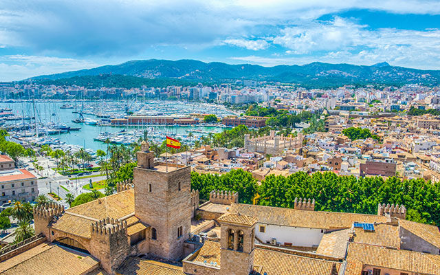
Palma de Mallorca location in Spain within the community of Balearic Islands
https://goo.gl/maps/4csZdPGdnEnMtMJR8
2. Natural geography
Nature and weather
Hydrography
According to reports from the Geological and Mining Institute of Spain, it receives 4.9 cubic hectometres of rain per year, 0.1 from irrigation return and 0.2 from residual water infiltration. Outlets by pumping are 6.7 cubic hectometres per year, but a project was carried out following the Balearic Hydrological Plan for its reduction.
Due to the torrential nature of the rainfall that occurred between the months of October and November, its hydrographic network contains a large flow with various torrents that run through its geography, presenting abrupt profiles that channel the currents towards the sea. Among them is the torrent de la Riera, which rises in the neighboring district of Puigpuñent and flows into the bay of Palma. The Coanegra torrent, which rises in the Orient town of Buñol and flows into the Gros torrent at Pont d'Inca. This is the longest, with 25 kilometers of route and with 345 km² of hydrographic basin. This wadi has two sources; in Puig del Teix and in the Sierra de Alfabia. It empties into the bay of Palma, where it delimits the neighborhoods of El Molinar and Coll d'en Rabassa.
Topography
Its relief is marked by the contrast between the mountains to the west of the term and in the rest of the municipality, with much flatter characteristics.
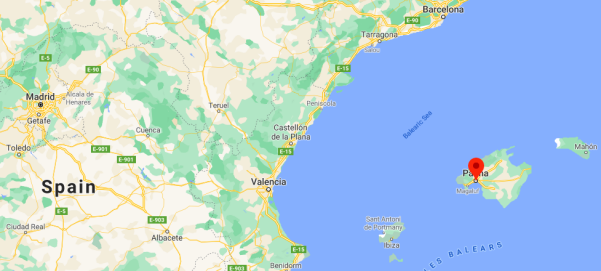
Its main mountain range is called Na Burguesa and it is located between the Son Vida urbanization and the Calviense estate of Son Falconer, and like the rest of the mountains of Mallorca, it has its origin in the Alpine orogeny. It is the southernmost area of the Sierra de Tramontana. In the past it was known as Portopí or Sierra d'en Bou. It has a height of 500 meters above sea level and is covered by important pine forest formations and Mediterranean scrub. The mountain ranges are composed of Triassic and Jurassic materials, limestone and dolomites mainly, with the presence of marl and gypsum as well. The mountain ranges present a complicated tectonic structure, which forms a folded relief with numerous thrusts, and quite fractured. The karst character of the Tramontana causes peculiar features in the rocks, especially numerous caves, and some sinkholes and lapiaces, etc.
The rest of the municipal area is relatively flat, with wide valleys filled by slightly deformed quaternary and tertiary materials, in a sub-horizontal arrangement, and small hills, made of Mesozoic materials, occasionally outcropping.
Its coastline is made up of calcareous materials (Calcarenite and similar), on which a varied vegetation is based depending on the substrate, rocky or sandy, and adaptation to salt, wind and lack of water as determining factors.
Flora and fauna
municipalities of Fuente Álamo de Murcia and Alhama de Murcia and that includes a large part of the mountains of the aforementioned South Mountain Range, being the green lung of the city. Within the park, the Carrascoy, Puerto and Cresta del Gallo mountain ranges are declared SCI, while the Cresta del Gallo, Villares, Columbares and Altaona mountain ranges also have ZEPA
Köppen Classification: Mediterran Climate
Under the Köppen Climate Classification climate classification, "dry-summer subtropical" climates are often referred to as "Mediterranean". This climate zone has an an average temperature above 10°C (50°F) in their warmest months, and an average in the coldest between 18 to -3°C (64 to 27°F). Summers tend to be dry with less than one-third that of the wettest winter month, and with less than 30mm (1.18 in) of precipitation in a summer month. Many of the regions with Mediterranean climates have relatively mild winters and very warm summers.
The Köppen Climate Classification subtype for this climate is "Csa". (Mediterran Climate).
The average temperature for the year in Palma is 64.2°F (17.9°C). The warmest month, on average, is August with an average temperature of 78.6°F (25.9°C). The coolest month on average is January, with an average temperature of 53.1°F (11.7°C).
The highest recorded temperature in Palma is 106.0°F (41.1°C), which was recorded in July. The lowest recorded temperature in Palma is 21.0°F (-6.1°C), which was recorded in January.
The average amount of precipitation for the year in Palma is 18.3" (464.8 mm). The month with the most precipitation on average is October with 3.0" (76.2 mm) of precipitation. The month with the least precipitation on average is July with an average of 0.3" (7.6 mm). There is an average of 52.0 days of precipitation, with the most precipitation occurring in October with 7.0 days and the least precipitation occurring in July with 1.0 days.
http://www.weatherbase.com/weather/weather-summary.php3?s=60380&cityname=Palma%2C+Balearic+Islands%2C+Spain&units=
Getting there and around
Get there
By plane – Palma's city airport (IATA: PMI) is the major airport in Mallorca and has daily flights from many European cities on national and budget carriers. The airport is managed by Aeropuertos Españoles y Navegación Aérea.
PMI is only 9 kilometers from the center of Palma. EMT's Line 1 bus service runs between the seaport, the city centre and the airport every fifteen minutes between 6:15am and 2:30am. The fare is €5 and can be purchased from the bus driver with cash. Locals are charged only €1.50 for the same journey.
By car – Travellers can only drive to Palma from other cities in Mallorca; there are no bridges or any road links to other islands or to the mainland. Most cities and towns in Mallorca have road links directly to Palma. There are several companies in Majorca that offer transfer facilities from the airport to any destination on the island.
By train – TIB [9] runs train services between Mallorcan towns. There is no train service to the airport. The main Train, Bus, and Metro station ('Estacio Intermodal') is underground, at Placa Espanya in Palma.
'Ferrocarril de Soller' operates the quaint wooden electric train from Placa Espanya in Palma to Soller town, in the north-west of the island, and from where you can continue your relaxing scenic journey to Puerto Soller on the companion Electric Tram. Information about the train is here.
By bus – EMT (Empresa Municipal de Transports) [10] runs the local bus service in Palma. Regional buses to destinations around the island are operated mainly by TIP. All EMT buses are equipped with onboard screens that state the current and next stop. EMT's line number A1 will take you from the airport through Palma downtown and to Paseo Mallorca. EMT line no. 1 starts from the main harbor (where most large cruise ships dock) and goes through downtown Palma to the new Palace of Congress. Line number A2 will take you from the airport to Arenal. As at September 2020 the fare for line A1 and A2 is €5 for non-residents of the island. There is only one fare on all EMT buses, so you don't need to specify your destination to the driver/conductor! All other local EMT destinations within Palma cost €1.50.
By ship – Any number of cruise ships berth at Palma, and there are also a number of ferry services to other Balaeric Islands and to the Iberian Peninsula.
Rideshare – Check out Blabla Car's carpooling service for rideshare options. A great option if you don't have a driver's license or want to avoid public transport.
https://wikitravel.org/en/Palma_de_Mallorca
COVID19 – International entry into Spain: subject to verification
Domestic travel is not restricted, but some conditions may apply
·Face masks are mandatory
·There is a social distancing requirement of 1.5 metres
·Domestic border crossings may be subject to approval, testing and quarantine
·Nationwide control measures in place
·Some COVID-19 travel conditions may apply in Spain and transport services are subject to change.
Get around
By bus or train – Buses and trains are the two forms of shared public transport in Palma de Mallorca. The local buses are run by Empresa Municipal de Transportes Urbanes de Palma de Mallorca (EMT) and are very frequent. They have particularly good coverage of the beaches and the centre of the city. Timetables and fares are available from the City Council. The main train system is operated by Serveis Ferroviaris de Mallorca (SFM), Mallorca Railway Services.
https://wikitravel.org/en/Palma_de_Mallorca
3. GDP
GDP: 33.716 M EUR (2019, Balearic Islands community)
https://datosmacro.expansion.com/ccaa/islas-baleares
4. Industry characteristics
The two main engines of the economy are tourism and construction, with industry and the primary sector (agriculture, livestock, fishing, mining) being relegated to the background. The hotel industries are among the first in Spain and even in the entire world. The areas that concentrate the greatest number of tourists are Playa de Palma and the city center.
Agriculture and Livestock
With the arrival of tourism during the 1970s, agriculture was relegated to the background in the municipal economy. It is mainly based on the cultivation of olive, carob and almond trees. Of the cattle ranch, the huts of pigs and sheep stand out and also a remarkable variety of fishing. In its municipal term there are numerous possessions that once constituted the sources of food supply for the population. Agriculture and, in general, the primary sector in Palma, is located in areas adjacent to other municipalities in the North districts (S'Indiotería or Son Espanyol among others) and Levante (Son Ferriol or Sa Casa Blanca among others).
Agricultural holdings, 695 according to the 1999 census, occupied 21,474 ha; 90% owned, 9% leased and 1% in other tenure regimes. 6,126 ha are cultivated (2,695 of herbaceous, 2,531 of fruit trees, 140 of olive groves, one of vineyards and 760 of other products), 214 are dedicated to permanent pastures, 11,107 to forestry operations and 4,027 ha are other non-forest lands. Most of them, 476, were less than five hectares, and 43 were over fifty hectares. The livestock units surveyed in 1999 were 4536: 1751 for cattle, 1746 for poultry, 783 for sheep, 354 for pigs, 114 for horses, fifty-five for goats and three mother rabbits.
Industry
Like agriculture, industry takes a back seat to Palma's economy. There are a total of 7222 companies dedicated to the industry, almost 15% of those in the Balearic community. Of these, 4,992 are engaged in construction, leaving only 2,230 that carry out industrial activities. Of the latter, 43 are dedicated to services related to the supply of water and electricity, 90 to the production of chemical products and derivatives, 844 are mechanical or metal-related workshops and 1,253 are manufacturing industries. Most of the industries are concentrated in the industrial estates of ASIMA (Association of Industrialists of Mallorca): Son Castelló and Can Valero.
Building
Along with tourism, construction is the sector that creates the most jobs in Mallorca. Due to the great geographical mobility of professionals who belong to the construction sector, the socioeconomic analysis of construction cannot be limited to the city of Palma, but rather is framed in the analysis at the island level. In 2008, a total of 4,992 companies dedicated to this economic sector were registered.
Since 2008, this sector, which has been a creator of jobs for several years, is suffering a huge crisis, due to the stoppage caused by financing difficulties to acquire new homes. However, in Palma the crisis is somewhat mitigated thanks to the fact that a large number of buildings in the historic neighborhoods of the city are being rehabilitated.
Services
Commercial distribution occupies a prominent place in Palma's services sector. Education, with the University at the forefront, enhances research. Health, mainly hospital, meets the needs of the population of the metropolitan area and tourism has a good network of hotels and restaurants of all sizes and categories. Also, in the city there is a wide network of branches of all the financial institutions of the country.
Commerce
Palma is a very important commercial plaza that in many respects serves a population that includes the city's own population, the island's and the entire Balearic archipelago. To cover all these objectives, there is a wide financial infrastructure in Palma where almost all the banking institutions that exist in Spain have one or several branches. At the time, the Caja de Ahorros Sa Nostra (ours in Majorcan) stands out, which had its headquarters in Palma, and which since 2010 is integrated into BMN (Banco Mare Nostrum). The city is also home to the regional addresses of many Banks and Savings Banks with a presence in the Balearic Islands.
For the entry and exit of products made or sold in the city and its area of influence, there is the port of Palma and the Son Sant Joan airport, which channel the flow of foreign trade, with a wide logistics area to facilitate the transfer of goods. The sea is the main commercial union between the islands and the rest of Spain.
5. Attractions
Plaça d'Espanya
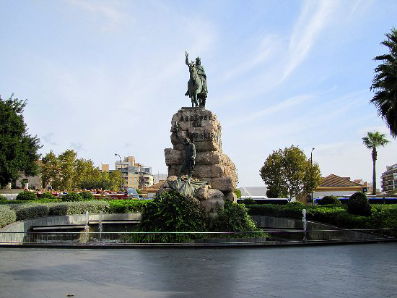
The Plaça d'Espanya is the transport hub of Palma. The Estació Intermodal caters for buses and trains (the latter controlled by TIB). The two old buildings are home to the tourist information centre and several cafés sit either side of the two large escalators which lead into the Estació, which sits underneath a large and popular park. On the lawns are several glass boxes, which let in light and ventilation to the station below ground. There are also train-themed playing structures, each one shaped like a train carriage and named after towns along the line of the Ferrocarril de Sóller, a railway dating back to 1911 which has its Palma Station right next to the park. Just down the street from here a new bus station is under construction. At the centre of the plaza is a statue of James I, Conquistador of Majorca.
Palma Cathedral
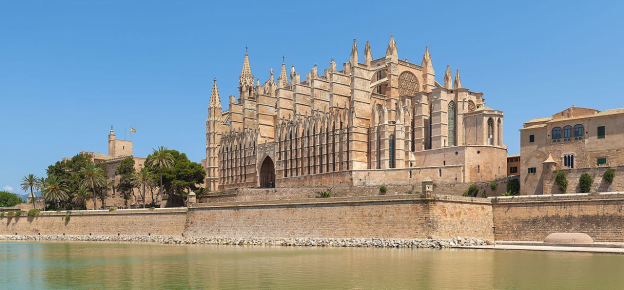
The Cathedral of Santa Maria of Palma (Cathedral of St. Mary of Palma), more commonly referred to as La Seu (a title also used by many other churches), is a beautiful Gothic Roman Catholic cathedral located in Palma, Mallorca, Spain.
Built by the Crown of Aragón on the site of a Moorish-era mosque, the cathedral is 121 metres long, 40 metres wide and its nave is 44 metres tall. By way of comparison, the height of the central nave reaches 33m in Notre Dame de Paris, 38m in Reims, 42m in Notre-Dame d'Amiens and 48m in Saint-Pierre de Beauvais, the highest of all Gothic cathedrals.
Designed in the Catalan Gothic style but with Northern European influences, it was begun by King James I of Aragon in 1229 but only finished in 1601. It sits within the old city of Palma atop the former citadel of the Roman city, between the Royal Palace of La Almudaina and the episcopal palace. It also overlooks the Parc de la Mar and the Mediterranean Sea.
In 1901, fifty years after a restoration of the cathedral had started, Antoni Gaudí was invited to take over the project. While some of his ideas were adopted – moving the choir stalls from the middle nave to be closer to the altar, as well as a large canopy – Gaudí abandoned his work in 1914 after an argument with the contractor. The planned changes were essentially cosmetic rather than structural, and the project was cancelled soon after.
https://en.wikipedia.org/wiki/Palma_Cathedral
Palma Old City
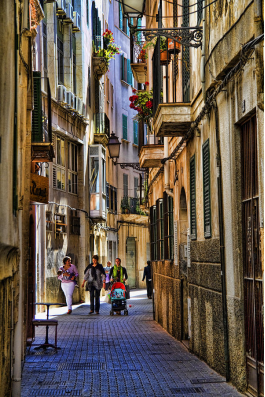
The Old City (in the south-east area of Palma behind the cathedral) is a maze of streets clearly hinting at an Arab past. With the exception of a few streets and squares which allow traffic and are populated with tourists most of the time, the walkways of this city quarter are fairly narrow, quiet streets, surrounded by a diverse range of interesting buildings, the architecture of which is comparable to cities such as Florence. The majority are private houses, some of which are open to the public as discreet museums or galleries. The Old City is also home to the Ajuntament (or Town Hall), the Convent of the Cathedral and the Banys Àrabs.
The Banys Àrabs, or Arab Baths, one of the few remnants of Palma's Moorish past, are accessed via the quiet Ca'n Serra street near the Convent of the Cathedral, and include the lush gardens of Ca'n Fontirroig, home to Sardinian warblers, house sparrows, cacti, palm trees and a wide range of flowers and ferns. The small two-roomed brick building that once housed the baths is of Byzantine origin, dating back to the 11th century and possibly once part of the home of a Muslim nobleman. The bathroom has a cupola with five oculi which let in dazzling light. The twelve columns holding up the small room were pillaged from an earlier Roman construction. The floor over the hypocaust has been worn away by people standing in the centre, mainly to photograph the entrance and the garden beyond it. The whole room is in a rather dilapidated condition. The other room is a brick cube with a small model of the baths as they once were in the corner.
Palma de Mallorca - What to do | Top Locations 2019
https://youtu.be/7uHMVJ3BsMo
6. History
Palma was founded as a Roman camp upon the remains of a Talaiotic settlement. The city was subjected to several Vandal raids during the fall of the Western Roman Empire, then reconquered by the Byzantine Empire, then colonised by the Moors (who called it Medina Mayurqa) and, in the 13th century, by James I of Aragon.
Roman period
After the conquest of Mallorca, the city was loosely incorporated into the province of Tarraconensis by 123 BC; the Romans founded two new cities: Palma on the south of the island, and Pollentia in the northeast – on the site of a Phoenician settlement. Whilst Pollentia acted as a port to Roman cities on the northwestern Mediterranean Sea, Palma was the port used for destinations in Africa, such as Carthage, and Hispania, such as Saguntum, Gades and Carthago Nova. Though present-day Palma has no significant remains from this period, occasional archaeological finds are made in city centre excavations. For example, the remains of the Roman Wall can be seen at Can Bordils, the Municipal Archive, and below it, at the Maimó ben Faraig Center.
Byzantine period
Though the period between the fall of the Western Roman Empire and the Muslim conquest is not well understood (due to lack of documents), there is clear evidence of a Byzantine presence in the city, as indicated by mosaics found in the oldest parts of the Cathedral, which was in early medieval times part of a paleo-Christian temple.
Muslim period
Between 902 and 1229, the city was under Islamic control. It remained the capital of the island and it was known as Medina Mayurqa, which in Arabic means "City of Majorca".
Under the Emirate of Córdoba
The arrival of the Moors in the Balearic Islands occurred at the beginning of the 8th century. During this period, the population developed an economy based on self-sufficiency and piracy, and even showed evidence of a relative hierarchy. The dominant groups took advantage of the Byzantine withdrawal due to Islamic expansion across the Mediterranean, to reinforce their domination upon the rest of the population, thus ensuring their power and the gradual abandonment of Imperial political structures.
In 707, a Muslim fleet, under the command of Abd Allgaht ibn Musa, son of the governor of Ifriqiya, Musa ibn Nusayr, stopped off at the island. It appears that Abd Allah convinced the powers of the city to accept a peace treaty. This treaty was granted in exchange for a tax, respect for social, economic and political structures to the communities that subscribed to it, as well as the continuity of their religious beliefs.
After 707, the city was inhabited by Christians who were nominally in allegiance to the sovereignty of the Umayyad Caliphate, yet who, de facto, enjoyed absolute autonomy. The city, being in Mallorca, constituted an enclave between western Christian and Islamic territories, and this attracted and encouraged increased levels of piracy in the surrounding waters. For wide sectors of the city's population, the sacking of ships (whether Muslim or Christian) which passed through Balearic waters was a source of riches over the next fifteen decades. Eventually, continued piracy in the region lead to a retaliation by Al-Andalus which launched a naval fleet against the city and the whole of the Islands. The Islands were defended by the emperor Charlemagne in 799 from a Muslim pirate incursion.
In 848 (maybe 849), four years after the first Viking incursions had sacked the whole island, an attack from Córdoba forced the authorities to ratify the treaty to which the city had submitted in 707. As the city still occupied an eccentric position regarding the commerce network established by the Moors in the western Mediterranean, the enclave was not immediately incorporated into Al-Andalus.
While the Emirate of Córdoba reinforced its influence upon the Mediterranean, Al-Andalus increased its interest in the city. The consequence of this was the substitution of the submission treaty for the effective incorporation of the islands to the Islamic state. A squad under the command of Isam al-Jawlani took advantage of instability caused by several Viking incursions and disembarked in Mallorca, and after destroying any resistance, incorporated Mallorca, with Palma as its capital, to the Córdoban state.
The incorporation of the city into the Emirate set the basis for a new society. Commerce and manufacturing developed in a manner that was previously unknown. This caused considerable demographic growth, thereby establishing Medina Mayurqa as one of the major ports for trading goods in and out of the Emirate of Córdoba.
Dénia—Balearic taifa (1015–1087)
The Umayyad regime, despite its administrative centralisation, mercenary army and struggle to gain wider social support, could neither harmonise the various ethnic groups inside al-Andalus nor dissolve the old tribes which still organised sporadic ethnic fighting. During the 11th century, the Caliphate's control waned considerably. Provinces broke free from the central Cordoban administration, and became effectively sovereign states — taifas — under the same governors that had been named by the last Umayyad Caliphs. According to their origin, these "taifas" can be grouped under three broad categories: people of Arab, Berber or Slavic origin.
Palma was part of the taifa of Dénia. The founder of this state was a client of the Al-Mansur family, Muyahid ibn Yusuf ibn Ali, who could profit from the progressive crumbling of the Caliphate's superstructure to gain control over the province of Dénia. Subsequently, Muyahid organised a campaign throughout the Balearic Islands to consolidate the district and incorporated it into their "taifa" in early 1015.
During the following years Palma became the main port from where attacks on Christian vessels and coasts could be launched. Palma was the base from where a campaign against Sardinia was launched between 1016 and 1017, which caused the Pisans and Genoese forces to intervene. Later, this intervention set the basis for Italian mercantile penetration of the city.
The Denian dominion lasted until 1087, a period during which the city, as well as the rest of the islands, was relatively peaceful. Their supremacy at sea was still not rivalled by the Italian merchant republics, thus there were few external threats.
Balearic Taifa (1087–1115) and Western Mediterranean
The Banu Hud conquest of Dénia and its incorporation to the Eastern district of the taifa of Zaragoza meant the destruction of the legacy of Muyahid. The islands were freed from mainland dominion and briefly enjoyed independence, during which Medina Mayurqa was the capital.
The economy during this period depended on both agriculture and piracy. In the latter 11th century, Christian commercial powers took the initiative at sea against the Muslims. After centuries of fighting defensively in the face of Islamic pressure, Italians, Catalans and Occitans took offensive action. Consequently, the benefits of piracy diminished causing severe economic stress on the city.
The clearest proof of the new ruling relation of forces, from 1090, is the Crusade organised by the most important mercantile cities of the Christian states against the Islands. This effort was destined to finally eradicate Muslim piracy mainly based in Palma and surrounding havens. In 1115, Palma was sacked and later abandoned by an expedition commanded by Ramon Berenguer III the Great, count of Barcelona and Provence, which was composed of Catalans, Pisans and other Italians, and soldiers from Provence, Corsica, and Sardinia, in a struggle to end Almoravid control.
After this, the Islands became part of the Almoravid dynasty. The inglobement[check spelling] of all the taifa to a larger state helped to re-establish a balance along the frontier that separated western Christian states from the Muslim world.
Period of the Banu Ganiya (1157–1203)
The situation changed in the mid-12th century, when the Almoravids were displaced from al-Andalus and western Maghreb by the Almohad. Almoravid dominions, from 1157 on, were restricted to the Balearic Islands, with Palma again acting as the capital, governed by Muhammad ibn Ganiya. Massive arrival of al-Andalus refugees contributed to reinforce the positions of the last Almoravid legitimatists, the Banu Ganiya, who, conscious of their weakness in the Western Mediterranean context, started to get closer to the growing powers represented by Italian maritime republics. Genoa and Pisans obtained in this period their first commercial concessions in the city and the rest of the islands.
The Banu Ganiya, taking advantage of the great loss suffered by Abu Yuqub Yusuf in the Siege of Santarém, attacked Ifriqiya, where the Almohad dominion had not been consolidated yet, in the same year. However, this attack was repelled and the Almohad authorities encouraged anti-Almoravid revolts in the Islands. The city was captured by the Almohads in 1203.
Christian reconquest and late Middle Ages
On 31 December 1229, after three months of siege, the city was reconquered by James I of Aragon and was renamed Ciutat de Mallorca (Mallorca City). In addition to being kept as capital of the Kingdom of Majorca, it was given a municipality that comprised the whole island. The governing arm was the University of the City and Kingdom of Majorca.
After the death of James I of Aragon, Palma became joint capital of the Kingdom of Majorca, together with Perpignan. His son, James II of Majorca, championed the construction of statues and monuments in the city: Bellver Castle, the churches of St. Francesc and St. Domingo, reformed the Palace of Almudaina and began the construction of the Cathedral of Majorca.
In 1391, anti-Jewish riots broke out. The Jewish community of Inca was completely wiped out, as were those of Sóller, Sineu, and Alcudia. In spite of the governor's prohibition on leaving the island, many Jews fled to North Africa. The remaining Jews were forced to convert under threat of death.
Abraham Cresques was a 14th-century Jewish cartographer of the Majorcan cartographic school from Palma; Cresques is credited with the authorship of the famous Catalan Atlas.
The river that cut through the city gave rise to two distinct areas within the city; the "Upper town" and "Lower town", depending upon which side of the river one was situated.
The city's advantageous geographical location allowed it extensive commerce with Catalonia, Valencia, Provence, the Maghreb, the Italian republics and the dominions of the Great Turk, which heralded a golden age for the city.
At the beginning of the 16th century, the Rebellion of the Brotherhoods (a peasant uprising against Charles V's administration) and the frequent attack of Turkish and Berber pirates caused a reduction of commercial activities and a huge inversion in defensive structures. As a consequence, the city entered a period of decadence that would last till the end of the 17th century.
17th to 19th centuries
The 17th century was characterised by the division of the city into two sides or gangs, named Canamunts and Canavalls (from Majorcan Catalan "the ones from the upper/lower side"), with severe social and economic repercussions. During this period, the port became a haven for pirates. During the last quarter of the century, the Inquisition continued its persecution of the city's Jews, locally called xuetes.
The fall of Barcelona in 1714 meant the end of the War of the Spanish Succession and the defeat and destruction of the Crown of Aragon, and this was reflected on the Nueva Planta decrees, issued by Philip V of Spain in 1715. These occupation decrees changed the government of the island and separated it from the municipality's government of Palma, which became the official city name. By the end of the 19th century, the name Palma de Mallorca was generalised in written Spanish, although it is still colloquially named Ciutat ("city") in Catalan. In the 18th century Charles III of Spain removed interdiction of commerce with Spanish colonies in America and the port and commercial activity of the city grew once again.
At the beginning of the 19th century, Palma became a refuge for many who had exiled themselves from the Napoleonic occupation of Catalonia and Valencia; during this period freedom flourished, until the absolutist restoration. With the establishment of contemporary Spanish state administrative organization, Palma became the capital of the new Balearic Islands province in the 1833 territorial division of Spain. The French occupation of Algeria in the 19th century ended the fear of Maghrebi attacks in Majorca, which favoured the expansion of new maritime routes, and consequently, the economic growth of the city.
Modern period
Since the advent of mass tourism in the 1950s, the city has been transformed into a tourist destination and has attracted many workers from mainland Spain. This has contributed to a huge change in the city's traditions, its language, and its economic power.
The boom in tourism has caused Palma to grow significantly. In 1960, Mallorca received 500,000 visitors, in 1997 it received more than 6,739,700. In 2001 more than 19,200,000 people passed through Son Sant Joan airport near Palma, with an additional 1.5 million coming by sea.
In the 21st century, urban redevelopment, by the so-called Pla Mirall (English "Mirror Plan"), had attracted groups of immigrant workers from outside the European Union, especially from Africa and South America.
More than half of the population works in tourism, approximately 80%, therefore being the main economic portal of Palma. Tourism has affected the rapid economic growth of Palma, making the island of Mallorca wealthier compared to other regions in Spain.
The second economic portal of Palma is agriculture. Main exports of Palma's agriculture are, almonds, oranges, lemons and olives. The island is also gifted with a wide variety of natural resources, such as mines of copper, lead and marble.
The city also has several surrounding neighborhood communities including Establiments, Nord, Son Espanyol, Ces Cases Noves, and Sa Creu Vermella.
7. Other Information: Palma Sports
Football is the most popular sport on the island, led by the Palma-based Segunda División club Real Mallorca, who play at the Estadi de Son Moix, and Segunda División B club CD Atlético Baleares.
Basketball is also a popular sport. Palma's top team is CB Bahía San Agustín, which plays its home games at the 5,076 capacity Palau Municipal d'Esports Son Moix.
Because of its maritime location all sea sports have also a big presence in Palma. Maybe the most important sporting event in the city is the Ciutat de Palma Prizes.
Road cycling is very popular in Mallorca. An international race for professional cyclists, the Vuelta a Mallorca, is held in February, the first day of which consists of a circuit race around the streets of Palma. The city is also home to the Palma Arena, a multi-platinum venue featuring a velodrome. The arena also hosted the Battle of Surfaces tennis event.
In June 2016, the city of Palma participated in the First World Company Sports Games which included five days of culture, sport and inclusivity within the community of Mallorca as a whole. It was operated through the World Federation Company Sport and was promoted for both local people and tourists to come together in the city. It became a large business venture by offering packages including accommodations close to the events and additional tourism information for future events.
8. Contact Information
City Mayor: José Francisco Hila

Phone number: +34 (971) 22 5900
Facebook: https://www.facebook.com/jose.hilavargas
Twitter: https://twitter.com/hila
Website: https://www.palma.cat
Govt. Office Address: Avinguda de Gabriel Alomar, 18, 07006, Palma, Illes Balears, Spain
